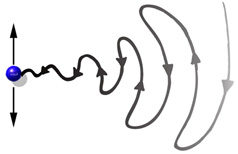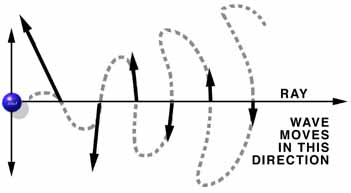More About Visualizing Electromagnetic Waves
 Before going on, Alex, there are a few important facts we need to discuss about the shape
of the line of electric force and why the wave is called an electromagnetic wave.
Before going on, Alex, there are a few important facts we need to discuss about the shape
of the line of electric force and why the wave is called an electromagnetic wave.
 You mean the wave we just saw when the charge on the spring vibrated isn't the whole story?
You mean the wave we just saw when the charge on the spring vibrated isn't the whole story?
 Close to the vibrating charge it gives the right picture, but farther away the shape of
the wave on the line of electric force changes considerably, like this --
Close to the vibrating charge it gives the right picture, but farther away the shape of
the wave on the line of electric force changes considerably, like this --
|

|
 But that looks crazy! Why does the wave get bigger farther away from the
vibrating charge?
But that looks crazy! Why does the wave get bigger farther away from the
vibrating charge?
 It doesn't get bigger! Remember, a line of electric force tells you nothing about how
strong the force would be on a (test) charge placed somewhere on the line. The line of
force only tells us the direction of the force on the charge. Think of the straight
line of force between two charges.
It doesn't get bigger! Remember, a line of electric force tells you nothing about how
strong the force would be on a (test) charge placed somewhere on the line. The line of
force only tells us the direction of the force on the charge. Think of the straight
line of force between two charges.
|

|
 So I can't tell how big the force is by looking at the line of force. How do I know the
direction of the force on a test charge?
So I can't tell how big the force is by looking at the line of force. How do I know the
direction of the force on a test charge?
 The direction of the force on a positive test charge put at some point on a line of force
is tangent to the line of force at that point.
The direction of the force on a positive test charge put at some point on a line of force
is tangent to the line of force at that point.
|

|
 So how do we know how big the force is?
So how do we know how big the force is?
 Well, think of the orbits experiment. When the force button is turned
on you can see how big the force is as you put the electron in various places near the proton. We
used some of the basic laws of electromagnetism to calculate the strength and direction of the
force on a (test) electron that you put down at rest. Arrows are used to indicate the strength as
well as the direction of the force. A long arrow means a big force, while a short arrow means a
weaker force.
Well, think of the orbits experiment. When the force button is turned
on you can see how big the force is as you put the electron in various places near the proton. We
used some of the basic laws of electromagnetism to calculate the strength and direction of the
force on a (test) electron that you put down at rest. Arrows are used to indicate the strength as
well as the direction of the force. A long arrow means a big force, while a short arrow means a
weaker force.
 So how about the wave we saw on a wiggling line of force from a vibrating charge? What
do the force arrows look like along that wave?
So how about the wave we saw on a wiggling line of force from a vibrating charge? What
do the force arrows look like along that wave?
 I can show you some of them. Let's draw a straight line out from the vibrating charge in the
direction the wave is moving. This line is called a ray. The forces on a (positive)
test charge put on the ray look like this:
I can show you some of them. Let's draw a straight line out from the vibrating charge in the
direction the wave is moving. This line is called a ray. The forces on a (positive)
test charge put on the ray look like this:
|

|
 So the force the wave would exert on a test charge really gets smaller farther away from
the vibrating charge?
So the force the wave would exert on a test charge really gets smaller farther away from
the vibrating charge?
 That's right, Alex, and far enough away we can use the arrows on the ray to visualize the
wave and forget about the lines of force, as in the picture below. The arrows show the
strength and the direction of the force a test charge would feel if it were put at
different points along the ray at a given instant of time. Notice that the forces are all
perpendicular to the ray!
That's right, Alex, and far enough away we can use the arrows on the ray to visualize the
wave and forget about the lines of force, as in the picture below. The arrows show the
strength and the direction of the force a test charge would feel if it were put at
different points along the ray at a given instant of time. Notice that the forces are all
perpendicular to the ray!

 I've seen that picture of an electromagnetic wave before, but with a curvy line drawn
through the arrow tips. Like this --
I've seen that picture of an electromagnetic wave before, but with a curvy line drawn
through the arrow tips. Like this --

 Isn't that curvy line a line of force?
Isn't that curvy line a line of force?
 No, it isn't a line of force at all. It's just a curve through the arrow tips -- a
different way of visualizing the wave. Sometimes the arrows are even left out completely.
No, it isn't a line of force at all. It's just a curve through the arrow tips -- a
different way of visualizing the wave. Sometimes the arrows are even left out completely.
 Why is that a good way to visualize an electromagnetic wave?
Why is that a good way to visualize an electromagnetic wave?
 Because then the picture becomes much more like a wave on a rope when you shake one end
and the other is held fixed.
Because then the picture becomes much more like a wave on a rope when you shake one end
and the other is held fixed.
|
For example, an electromagnetic wave like this
exerts weaker forces than a wave like this |

|
even though they have the same wavelength. The second wave is more intense or, in the case of
light waves, "brighter".







